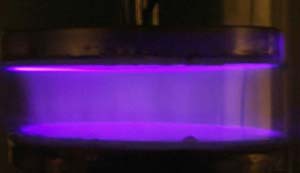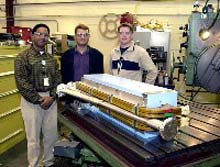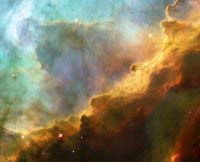Physics and Astronomy
This area deals with the fundamental laws and building blocks of nature and how they interact, the properties and the behavior of matter, and research into space and time and their structures.
innovations-report provides in-depth reports and articles on subjects such as astrophysics, laser technologies, nuclear, quantum, particle and solid-state physics, nanotechnologies, planetary research and findings (Mars, Venus) and developments related to the Hubble Telescope.

Astronomers map the hidden Universe
Astronomers from Cardiff University are completing the first survey ever for cosmic hydrogen, the primeval gas which emerged from the Big Bang to form all the stars and galaxies we can see today.
Since 1997 the astronomers, with their Australian colleagues, have been using two giant radio telescopes, the 64-metre diameter dish at Parkes in New South Wales, Australia, and the 76-metre dish at Jodrell Bank in Cheshire, England to build up an atlas of the heavens as mapped by cosmic hydrogen.

New Jersey Institute of Technology physicist uncovers new information about plutonium
The storage of plutonium has long plagued scientists. “It is a dangerous metal and its long term storage must be done with special care so as not to harm the environment, ”said physicist Serguei Savrasov, Ph.D.
Finding a solution to this problem led Savrasov, an associate professor at New Jersey Institute of Technology (NJIT), and a team of researchers at Rutgers University and Los Alamos National Laboratories, to study how this metal reacts to heat, a natural condition of storage over time

Self-organization: the quest for the origin and evolution of structure
Self-organization is a growing interdisciplinary field of research about a phenomenon that can be observed in the Universe, in nature and in social contexts. Researchers seek explanations by using both experimental, often computer-based approaches and empirical, observational approaches. Mechanisms of self-organization are beginning to be identified and the theoretical foundation is under development. Research on self-organization tries to describe and explain forms, complex patterns and behaviours t

The lethal fourth state
The use of toxic chemicals to sterilise medical instruments may soon be a thing of the past, according to researchers at Old Dominion University in Norfolk, Virginia, and the University of California in San Diego. Their work, released on 30 April 2003 in New Journal of Physics, published jointly by the Institute of Physics and the German Physical Society, tests a new way of killing bacteria using a plasma at room temperature and pressure, which could have applications in decontamination of biological

Energy recovery experiment could lead way to new accelerators
Jefferson Lab physicists will soon begin their own version of reuse — not with run-of-the-mill materials, but with radiofrequency energy and the high-energy electrons that they energize.
Newspaper, glass and aluminum recycling has become commonplace for most households and businesses. Jefferson Lab physicists will soon begin their own version of reuse — not with run-of-the-mill materials, but with radiofrequency energy and the high-energy electrons that they energize.
In an

A perfect storm of turbulent gases
Like the fury of a raging sea, this anniversary image from the NASA/ESA Hubble Space Telescope shows a bubbly ocean of glowing hydrogen, oxygen, and sulphur gas in the extremely massive and luminous molecular nebula Messier 17.
This Hubble photograph captures a small region within Messier 17 (M17), a hotbed of star formation. M17, also known as the Omega or Swan Nebula, is located about 5500 light-years away in the Sagittarius constellation. The release of this image commemorates the thirte